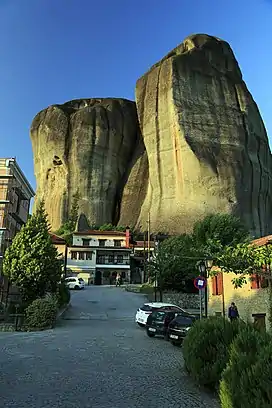Holy Spirit Rock
The Holy Spirit Rock or Holy Ghost Rock, also known as the Agion Pneuma in Greek, is a rock in the Meteora rock formation complex of Thessaly, Greece.[3]
| Holy Spirit | |
|---|---|
| Agion Pneuma | |
 View of the Holy Spirit Rock from Kastraki | |
| Highest point | |
| Elevation | 600 m (2,000 ft)[1] |
| Coordinates | 39°43′08″N 21°37′29″E[2] |
| Geography | |
| Location | Meteora |
| Country | Greece |
| Administrative region | Thessaly |
| Regional unit | Trikala |
| Settlement | Kalabaka |
Monasteries and sites
The Monks' Prison (Filakaé Monakón) (39°43′13″N 21°37′38″E) is built in long vertical crevice on the eastern side of the Holy Spirit Rock.[4] From Kastraki, it can be reached via an unmarked hiking trail.
The ruins of the Agiou Pneuma Monastery ("Monastery of the Holy Spirit") are located on the rock (39°43′06″N 21°37′30″E). The Monastery of the Holy Spirit is built on a 300-metre high cliff. A path carved into the cliff leads to the church, which has survived to this day. The frescoes have completely decayed. The altar, sacristy, and prayer book are carved into the rock, and at the entrance to the right is a carved coffin where the clergyman's grave is located. To the left of the shrine are two cisterns for collecting rainwater. There are abandoned cells and trees in several places. At the top of the cliff is an iron cross, said to have been erected by the Serbian king Stefan Dušan.[5]
The Monastery of St. George of Mandila (39°43′06″N 21°37′21″E) is also located on the rock. Kerchiefs (mandilia) are traditionally hung at the cave entrance. It may have been one of the four monasteries founded around 1367 by Neilos, the Prior of the Skete of Stagoi. The Cave of St. George of Mandila may be the same as the Cave of Archimandrite Makarios near Pigadion.[4] The base can be easily reached from Kastraki, but rock climbing is needed to reach the actual cave.
Stylos Stagon (Στύλος Σταγών), a rock pillar, is part of the Holy Spirit rock complex.[4]
The Monastery of Theostiriktos (Μονή Θεοστηρίκτου) is located in the Holy Spirit Rock area, but its exact location is uncertain.[4]
Access
A network of trails surrounding the rock can be reached from the village of Kastraki.
References
- "Μετέωρα: Ικριωματικά καταφύγια" (PDF). Δημοκρίτειο Πανεπιστήμιο Θράκης (Τμήμα Αρχιτεκτόνων Μηχανικών). December 2019. Retrieved 2022-06-08.
- "Node: Άγιο Πνεύμα (1333712585)". OpenStreetMap. 2020-04-26. Archived from the original on 2022-06-04. Retrieved 2022-06-03.
- "Meteora, Rock climbing". theCrag. 2016-05-11. Archived from the original on 2022-06-04. Retrieved 2022-06-03.
- "Μετεωρικές μονές: Συμβολή στον απαιτούμενο και ευκταίο διάλογο". Σπυρίδων Βλιώρας (Προσωπική ιστοσελίδα) (in Greek). Archived from the original on 2021-02-04. Retrieved 2022-06-02.
- Provatakis, Theocharis M. (2006). Meteora: History of monasteries and monasticism. Athens: Michalis Toubis Publications S.A. ISBN 960-540-095-2.